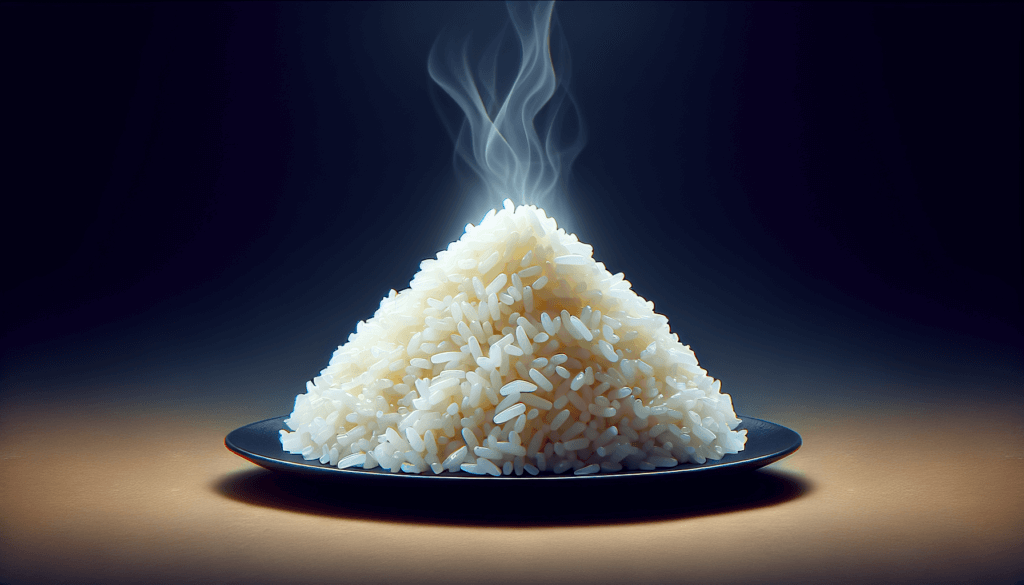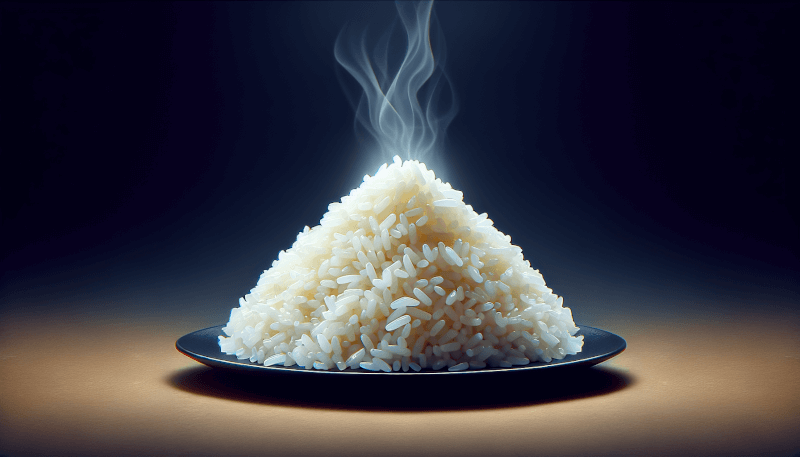So you’ve decided to venture into the world of cooking and one dish you want to master is rice. Well, you’re in luck because this beginner’s guide is here to help you cook perfect rice every single time. Whether you’re making a simple side dish or a flavorful main course, the key to achieving fluffy and delicious rice lies in a few simple steps. By following these tips and tricks, you’ll soon become a rice-cooking pro in no time. So grab your apron and let’s get started on this culinary journey!

Choosing the Right Type of Rice
Understanding the Different Types of Rice
When it comes to cooking rice, the first step is to choose the right type of rice for your dish. There are several varieties of rice available, each with its own unique characteristics and flavors. The most common types of rice include white rice, brown rice, jasmine rice, basmati rice, and sushi rice.
White rice is the most widely used type of rice, known for its fluffy texture and mild taste. Brown rice, on the other hand, is a whole grain rice that retains the bran and germ, making it a healthier option. Jasmine rice is a fragrant rice with a delicate aroma and slightly sticky texture, perfect for pairing with Thai or Asian dishes. Basmati rice is another aromatic rice variety that is popular in Indian and Middle Eastern cuisine. Lastly, sushi rice is a short-grain rice that is essential for making sushi rolls.
Factors to Consider in Choosing Rice
When choosing rice, consider the dish you plan to prepare and the desired texture of the rice. For light and fluffy rice, white rice or jasmine rice is a great choice. If you’re looking for a nuttier and chewier texture, brown rice is the way to go. Basmati rice is perfect for dishes that require a long-grain rice, while sushi rice is essential for making sushi rolls.
Another factor to consider is the cooking time. White rice and jasmine rice generally cook faster compared to brown rice or basmati rice. If you’re in a hurry or need a quick meal, white rice or jasmine rice is the ideal option.
Lastly, take into account your personal preferences and dietary needs. If you prefer a more nutritious option, brown rice is the best choice. Additionally, if you follow a gluten-free diet, rice is naturally gluten-free, making it a safe option for those with gluten sensitivities or celiac disease.
Equipment Needed for Cooking Rice
Basic Cookware
To cook rice, you’ll need some basic cookware. A medium-sized saucepan with a tight-fitting lid is essential for stove-top cooking. Make sure the saucepan is large enough to hold the desired amount of rice and water, allowing room for expansion.
Additional Tools for Rice Cooking
While a saucepan and lid are the basic tools needed for cooking rice, there are a few additional tools that can make the process easier and more efficient. A rice cooker is a convenient appliance specifically designed for cooking rice. Rice cookers automate the process, ensuring perfectly cooked rice every time. Measuring cups and a fine-mesh strainer are also helpful for accurately measuring the rice and rinsing off excess starch.

Preparing the Rice
Rinsing the Rice
Before cooking rice, it’s important to rinse it to remove any excess starch. Rinsing the rice helps create a fluffier end result. To rinse the rice, place it in a fine-mesh strainer and hold it under running water. Gently rinse and agitate the rice with your hands until the water runs clear.
Soaking the Rice (Optional)
Soaking rice before cooking is optional but can help improve the texture and shorten the cooking time, especially for certain varieties like basmati rice. To soak the rice, place it in a bowl and cover it with water. Let it sit for 15-30 minutes before draining the water.
Measuring the Rice and Water
Proper measurement of rice and water is crucial for cooking perfect rice. As a general rule, use a 1:2 ratio of rice to water for long-grain varieties like white rice, jasmine rice, and basmati rice. For brown rice, use a 1:2.5 ratio of rice to water. However, these ratios can vary slightly depending on personal preference and the specific type of rice. Follow the instructions on the rice package for the recommended rice-to-water ratio.
Cooking Methods for Rice
Stovetop Method
The stovetop method is the traditional way of cooking rice and requires a saucepan and lid.
Bringing the Water to a Boil
Start by adding the desired amount of water to the saucepan and bringing it to a boil over high heat.
Adding the Rice and Seasonings
Once the water reaches a rolling boil, add the rinsed rice to the saucepan. You can also add seasonings like salt or butter at this stage for added flavor.
Simmering the Rice
Lower the heat to low or medium-low and cover the saucepan with the lid. Allow the rice to simmer for the specified cooking time, usually around 15-20 minutes for white rice or 40-45 minutes for brown rice.
Allowing the Rice to Rest
After the cooking time is complete, remove the saucepan from the heat and let the rice rest, covered, for an additional 5-10 minutes. This resting period allows the rice to absorb any remaining liquid and ensures an evenly cooked and fluffy texture.
Rice Cooker Method
A rice cooker is a convenient and foolproof way of cooking rice. It automates the process, eliminating the need to monitor the cooking progress.
Using the Correct Rice-to-Water Ratio
Before adding the rice to the rice cooker, measure the desired amount of rice using the measuring cup provided with the cooker. The markings on the inside of the rice cooker pot indicate the corresponding water levels.
Adding the Rice and Seasonings
Add the rinsed rice to the rice cooker pot and add any seasonings or flavors according to your preferences. Mix gently to distribute the seasonings evenly.
Setting the Rice Cooker
Place the rice cooker pot in the rice cooker, close the lid, and set the cooking mode as per the rice cooker’s instructions. Different rice cookers have different settings, such as white rice, brown rice, or multi-grain. Select the appropriate setting for your type of rice.
Letting the Rice Rest
Once the rice cooker completes the cooking cycle, let the cooked rice rest in the rice cooker with the lid closed for about 10-15 minutes. This short resting period allows the rice to steam and settle, resulting in a perfect and fluffy texture.
Instant Pot Method
The Instant Pot has gained popularity for its versatility and efficiency in cooking a variety of dishes, including rice.
Understanding the Instant Pot Settings
Familiarize yourself with the different settings on your Instant Pot. Depending on the model, you may have settings such as rice, pressure cook, or manual. Each setting has its specific purpose and cooking time.
Using the Correct Rice-to-Water Ratio
Measure the desired amount of rice using the Instant Pot’s measuring cup and rinse it under cold water. For most types of rice, use a 1:1.5 ratio of rice to water. Adjust the amount of water based on personal preference and the specific type of rice.
Adding the Rice and Seasonings
Add the rinsed rice to the Instant Pot and add any seasonings or flavors according to your preferences. Mix gently to evenly distribute the seasonings.
Setting the Instant Pot
Close the Instant Pot lid securely and select the appropriate setting for your type of rice. If your Instant Pot has a rice setting, use that. Alternatively, you can manually set the pressure cooking time using the manual or pressure cook setting and adjust the time accordingly. Refer to the Instant Pot’s manual for the recommended cooking times for different types of rice.
Releasing the Pressure
Once the Instant Pot completes the cooking cycle, allow the pressure to release naturally for 10-15 minutes. After that, carefully release any remaining pressure by using the quick release valve. Open the Instant Pot lid and fluff the cooked rice with a fork before serving.

Enhancing the Flavor of Rice
While rice can be delicious on its own, there are several ways to enhance its flavor and make it even more enjoyable.
Using Broth Instead of Water
Instead of using plain water, try using broth to cook your rice. Using vegetable broth, chicken broth, or beef broth can infuse the rice with extra flavor and depth.
Adding Spices and Aromatics
Add spices and aromatics to the rice while it is cooking to create a flavorful base. Common spices and aromatics include garlic, onion, ginger, cumin, turmeric, and bay leaves. These ingredients can transform plain rice into a delicious side dish or main course.
Incorporating Vegetables and Herbs
To make your rice even more nutritious and flavorful, consider adding vegetables and herbs. Sauté some diced vegetables like carrots, bell peppers, peas, or corn and mix them into the cooked rice. You can also add fresh herbs like cilantro, parsley, or basil for an extra burst of freshness.
Troubleshooting Common Issues
Even with the best techniques, cooking rice may sometimes result in common issues. Here are some troubleshooting tips to help you overcome these problems.
Gummy or Soggy Rice
If your rice turns out gummy or soggy, chances are there was too much water or the rice was overcooked. To fix this, try reducing the amount of water used the next time you cook the rice. Additionally, it’s important to follow the specified cooking times and avoid overcooking the rice.
Burnt Rice at the Bottom
Burnt rice at the bottom of the pot is often the result of using high heat or not adding enough water. To avoid this, cook the rice on low or medium-low heat and ensure there is enough water in the pot. If the rice still sticks to the bottom, try using a non-stick pot or coating the bottom of the pot with a thin layer of oil.
Rice Sticking to the Pot
To prevent rice from sticking to the pot, make sure to rinse the rice thoroughly to remove excess starch. Additionally, using a non-stick pot or adding a small amount of oil to the pot can help prevent sticking. Avoid stirring the rice too frequently while it’s cooking, as this can release excess starch and make the rice sticky.

Creative Rice Recipes
While plain rice is versatile and delicious, there are countless creative recipes that take rice to the next level. Here are a few popular rice-based dishes:
Fried Rice
Fried rice is a versatile and satisfying dish that can be customized with various ingredients. Start with cold cooked rice and sauté it with vegetables, protein of your choice (such as chicken, shrimp, or tofu), and seasonings like soy sauce or sesame oil. Add in additional flavors like ginger, garlic, and eggs for a delicious and quick meal.
Rice Pilaf
Rice pilaf is a flavorful and aromatic rice dish often cooked with vegetables, spices, and broth. Sauté rice with diced onions, garlic, and your choice of vegetables in butter or oil. Add broth and seasonings like bay leaves, thyme, or cumin. Let it simmer until the rice is cooked and fluffy. Rice pilaf makes a great side dish or can be enjoyed as a main course with the addition of protein.
Creamy Risotto
Risotto is a creamy and comforting rice dish that originates from Italy. It’s typically made with Arborio or Carnaroli rice, which has a high starch content, resulting in a rich and creamy texture. Sauté diced onions and garlic in butter or oil, then add the rice and slowly add warm broth, stirring constantly until the rice is cooked and creamy. Add ingredients like mushrooms, peas, or parmesan cheese to customize your risotto.
Cooking rice may seem daunting at first, but with the right techniques and a little practice, you’ll be able to achieve perfectly cooked rice every time. Experiment with different types of rice, flavors, and recipes to discover your favorite rice dishes. So go ahead, embrace the art of cooking rice and enjoy delicious and satisfying meals!


